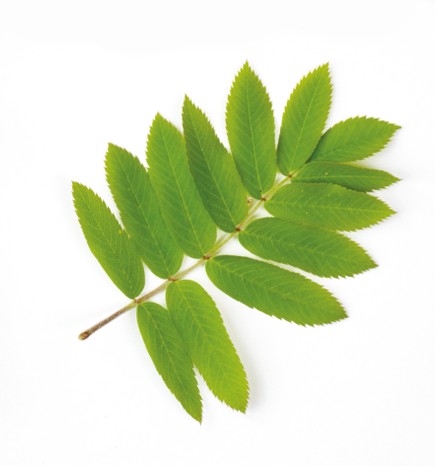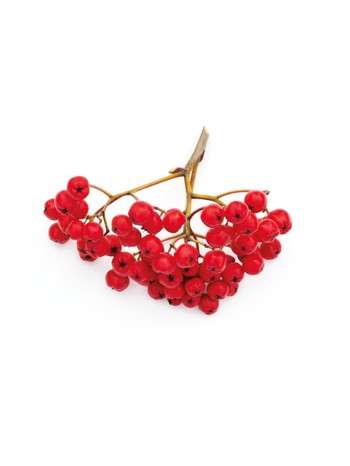
How to identify hawthorn, crab apple and rowan trees
Lia Leendertz explains how you can spot rowan, crab apple and hawthorn by learning the blossoms, fruits and nuts in British hedgerows. Photos Jason Ingram, illustrations Liam McAuley
The trees growing in British hedgerows are often the most common. If you grew up in the countryside, you will no doubt be familiar with the old wives tales associated to the hawthorn bush and the joy of moulding hazel twigs into trusty, but harmless, weapons. Here, Lia Leendertz explains how you can identify the much-loved rowan, hawthorn and crab apple trees throughout the seasons and lists key features of each.
Sorbus aucuparia – Rowan

The rowan tree lives a double life. Due to its extreme hardiness and its tolerance of tough conditions, rowan is found higher up mountainsides than any other tree except the silver birch, and is often called the mountain ash because of this. But it is also one of the most domesticated of trees, often planted well away from its wilder habitat. It frequents gardens in towns and in the countryside, where it never gets too big for its bounds and its neat habit, pretty spring blossom and autumn display of lipstick-red berries can be appreciated up close. This association of homes and rowans is not purely ornamental, however, and harks back to a belief that the rowan has protective qualities. It has long been widely planted near doorways as protection against witches and other bad spirits.
Bark
The bark is smooth, shiny and grey. Winter twigs are grey and young trees have hairy buds.

Leaves
The leaves comprise between six and eight pairs of leaflets, and bear a similarity to ash leaves. Each individual leaflet has a serrated edge.

Flowers
Creamy-white heads of five-petalled flowers appear in April and May. They have an unpleasant smell, but are attractive to insects.

Berries
Heavy bunches of beautiful, bright-red, shiny berries are produced in September and October. Each individual berry bears a tiny star. Birds, especially waxwings, love to feast on the berries.

Silhouette
A graceful and open-canopied tree, neat, round-headed and open in stature. It grows to a maximum of around 15m and can live for as long as 200 years.

Malus sylvestris – Crab apple

One of the prettiest small trees there is, the crab apple is more often seen in gardens than it is in the wild. Its compact size and two distinct seasons of interest make it suitable for small gardens: in spring it is covered in big white and pink blossom, and in autumn it bears beautiful miniature apples that can hang on the tree for months. However, it can still be found in relics of old oak woodlands and in sheltered spots on the edges of forests, as well as in hedgerows. It is an ancestor of the cultivated apple and can live for up to 100 years, becoming ever more gnarled and twisted as it ages. Lichens cover the branches of older trees and the crab apple is one of the few plants that plays host to mistletoe, so you may see evergreen bunches of this Christmas favourite in the branches once the leaves have fallen.
Bark
The rough, flecked, grey-brown bark cracks as it ages, the trunk grows gnarled and twisted, and the twigs can develop spines.

Leaves
Mid-green leaves are round to oval, with serrated edges and a pointed tip that leans to one side. They are borne alternately along the branch.

Flowers
The beautiful, simple, open blossom appears around April. The pink buds open to pure-white, five-petalled flowers with pink backs to the petals. It has a sweet scent that is attractive to insects.

Crab apples
Round, green, cherry-sized apples are produced in September and slowly ripen to yellow by around October. They are a good source of winter food for birds.

Silhouette
The crab apple grows to around 10m in height and has a wide, rounded, spreading canopy that is often open and irregular. It grows craggy, twisted and characterful with age.

Crataegus monogyna – Hawthorn

Hawthorn is one of the most common plants in the English countryside, and is most often seen as a hedge around permanent pasture. This is because it has been the principal plant of field enclosure since Tudor times, its dense, spiny growth making a perfect stock-proof hedge. It has several common names – hawthorn, quickthorn, whitethorn and May – the latter after the month in which it produces frothy white flowers, one of the spectacles of the natural year. It is also seen as a gnarled and characterful small tree, particularly in more remote areas. Leaves and flowers are sometimes added to salads, and the berries are used in jam making and to create syrup rich in vitamin C. There are many superstitions around hawthorn, and bringing branches into the house is associated with illness and death.
Bark
Very young stems have a reddish colour turning red-brown, with thorns protruding below the leaf joints and sometimes at the tips of the shoots. Older bark is brown, fissured and cracked.

Leaves
The small, bright-green leaves are as broad as they are long and deeply lobed, cut at least halfway to the central leaf rib. They turn buttery yellow in autumn.

Flowers
Small, white, five-petalled flowers appear after the leaves in May (an easy way to distinguish hawthorn from blackthorn). They have a strong and not particularly pleasant scent.

Berries
Around October, the dark-red haws mature in clusters. They are loved by birds, particularly in the later part of winter.

Silhouette
Most often grown as a thick hedge, but in remote spots it can be seen as a gnarled and twisted small tree with a spreading, uneven canopy.

Don't miss The best wood for burning
Authors

Niwaki bundle worth £57 when you subscribe
Subscribe to Gardens Illustrated magazine and claim your Niwaki bundle worth £57
*UK only

Container Gardening Special Edition
The Gardens Illustrated Guide to Container Gardening.
In this special edition, discover colourful flower combinations and seasonal planting schemes for pots designed by leading plantspeople, and essential know-how for container gardening success. Just £9.99 inc UK p&pBy entering your details, you are agreeing to our terms and conditions and privacy policy. You can unsubscribe at any time.

Gardens of the Globe
From botanical wonders in Australia to tranquil havens closer to home in Ireland, let this guide help you to discover some of the most glorious gardens around the world
By entering your details, you are agreeing to our terms and conditions and privacy policy. You can unsubscribe at any time.




